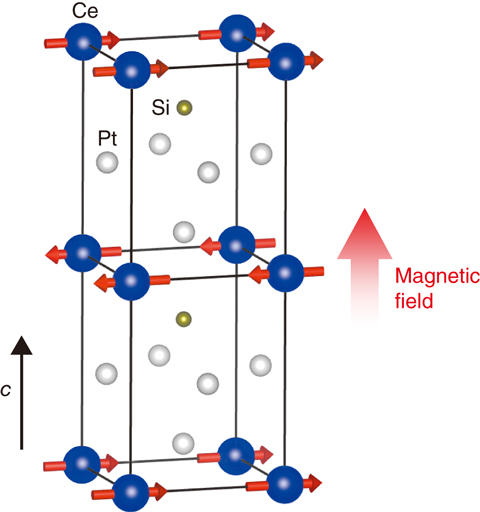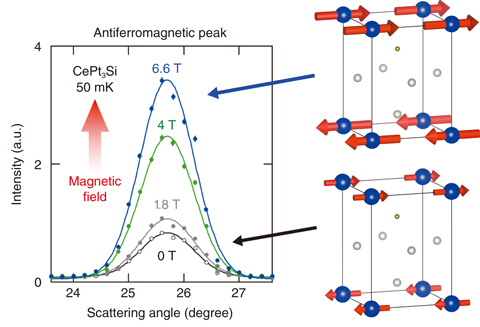
Fig.5-16 Crystal and antiferromagnetic structure of CePt3Si with a schematic experimental configuration

Fig.5-17 Magnetic-field response of the antiferromagnetic peak
Superconductivity emerges from the formation of bound pairs of electrons, the so-called Cooper pairs, which originate from an attractive force between electrons. Whilst lattice vibration plays a dominant role in conventional superconductors, unconventional superconductivity is believed to arise mostly from magnetic fluctuation. In fact, the majority of unconventional superconductors have been discovered in the vicinity of a magnetic critical point, where magnetic fluctuation is strongly enhanced.
Conversely, superconductivity in CePt3Si is realized in a long-range antiferromagnetic ordered state. The antiferromagnetic order in CePt3Si is characterized as a ferromagnetic basal c-plane stacked alternatively along the c-axis (Fig.5-16). It is of great interest to determine how antiferromagnetic order can coexist with superconductivity.
Determining an external field response is a useful approach to unveiling the true nature of the state of matter. Here, we applied an external magnetic field to understand antiferromagnetism in CePt3Si. Owing to its transparent character, neutron scattering is highly compatible with an extreme sample environment such as high-magnetic-field and low-temperature as well as a sensitive probe for studying antiferromagnetism. Therefore, we conducted neutron-scattering experiments under high magnetic field at temperatures as low as 50 mK using the V2 spectrometer at Helmholtz-Zentrum-Berlin (Germany) and the IN14 spectrometer at Institut-Laue-Langevin (France). In typical antiferromagnets, a staggered moment arrangement is unfavorable against a uniform magnetic field and collapses with an increasing applied field. Contrarily, the antiferromagnetic peak intensity is strongly increased by a factor of more than 4 with magnetic fields (Fig.5-17). This increase in intensity suggests an enhancement of the antiferromagnetic moment. This enhanced magnetic moment under a magnetic field implies an underlying hidden magnetic moment at a zero field, a unique character of the antiferromagnetic order of CePt3Si. Therefore, it may help to reveal the mechanism of this field-induced moment enhancement for understanding the coexistence of superconductivity and magnetism in CePt3Si.
This work is performed under a framework for collaborations on actinide-compound research among the JAEA, the CEA (Grenoble, FR), and the ITU (Karlsruhe, DE).